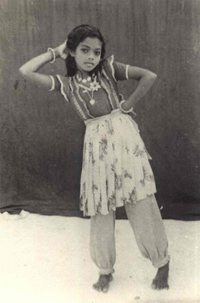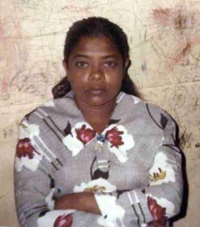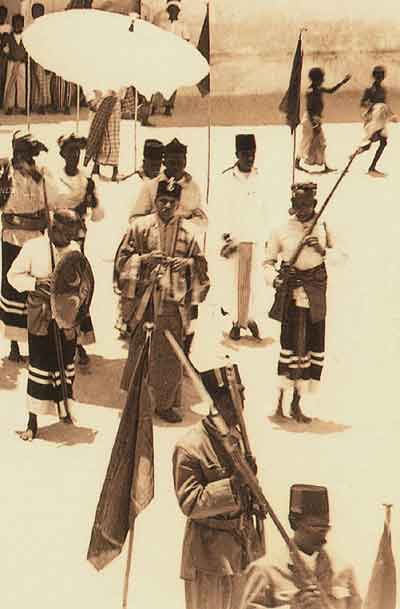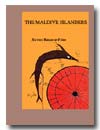| 7 July 2009
Gaage Naima
By Xavier Romero-Frias
Gagee Naima was not a member of the Royal dynasty of Huraagey and Hilaaly. The Sultan Hassan Nooreddine II married her aunt, who is a member of the Malé island family called Gaage. Xavier Romero-Frias is Naima's son-in-law
|
Gaage Naima, or Fathumathu Naima, was born on the 7th May 1951 in Malé. She was related to the Maldivian Royal Family. Naima was a talented Maldivian dancer who languished in obscurity.
Naima's mother died when she was only 4 and her father shortly thereafter. She was looked after by a palace official, along with her brothers and sisters.
Naima was trained as a dancer at the early age of 9. Her dance instructor was Okko Muhammad Fulhu , a man who devoted his life to preserving ancient Maldivian traditions. Naima underwent her training along with other girls, but soon she proved to be the best dancer. She found her interest and vocation in this artistic expression. The discipline that Okko Muhammad Fulhu taught her was based on the Northern Indian Kathak. But Naima had talent and incorporated many traditional Maldivian elements (from children's games or fishermen's dances) she learned from her instructor into the dances on her own. Even her master was amazed at her genius and good ideas.
Already in the early 1950s regent Muhammad Amin, after modernizing the Maldivian military, had the idea of creating a dance group in the Maldives as part of official protocol. The idea was continued over a decade later, after the restoration of the monarchy, under Sultan Muhammad Farid. Then it was decided to create an official dancing troupe of the Maldives based on the style of the Royal Cambodian ballet.
A contest was staged, and in 1964, at the age of 13, Naima joined the budding official Maldivian Royal dance group. Naima became the premiere dancer of the group during the training period, for she enjoyed dancing and put her whole soul into it. Her skill in dancing stirred bitter jealousies though. Some people, resenting the attention Naima was getting from high officials, lashed her severely with their tongues. It was easy for the slanderers to do so. There were religious authorities that were opposed to the idea of having an official group of female dancers since the beginning.
In the midst of the hostile atmosphere, it was difficult for a young woman like Naima to keep the delicate ancient flowers of court refinement and artistic skills alive. Barely one year after having been started, the stiff religious opposition bore results and the official dancing troupe was disbanded while its members were still undergoing training.
Naima, only 15, established herself as a dancer on her own, training people she chose. She also performed dances at private celebrations. But the self-righteous lashing tongues would not stop. They would keep torturing her, demoralizing her and pulling down her efforts to soar in the noble art of dancing. They said her life was forfeited and that she would go to hell. Finally, Naima realized that she had not the strength to fight back the jealous hatred aroused by her dancing skills and gave up. Deprived of the possibility of exercising her artistic vocation, something in Naima died before her time. She was forced to live in average mediocrity, a dull state pleasing to the religious powers. But the slander Naima had suffered in the past had been so severe that it bred an anxiety that would haunt her for the rest of her life.
Naima, whose flowering creativity was stifled for over forty years, endured a life in muffled anxiety. One shudders at the thought of how many other geniuses have been stifled in the Maldives by religion. One wonders how such mindless destruction can be helpful for the interests of the Maldives as a nation. One grieves deeply for the slow death and the undeserved indignity Naima had to endure, seeing her talents and her body lose strength without being able to bloom, an important part of her living perpetually in sorrow. Her creativity had been killed in the bud by the harsh, persistent winds that have blown fiercely all these years of artistic sterility in the Maldives.
Naima died in Malé on Saturday, the 20th June 2009, she had lived most of her life in the capital of the Maldives. Naima is survived by one older brother and a younger sister.
Gaaghe Naíma no era miembro de la Real dinastía Huraagey y Hilaaly. El rey Hassan Nooreddine II se casó con su tía, quien es miembro de la familia de Malé llamada Gaaghe. Xavier Romero-Frias es el yerno de Naima.
|
Gaaghe Naíma - Necrologia
Por Xavier Romero-Frias
Gaaghe Naíma, o Fatumatu Naíma, nació el 7 de mayo del año 1950 en Malé, islas Maldivas. Naíma fue una bailarina de talento que hubo de conformarse con una vida de oscuridad. Estaba emparentada con la familia real Maldiva. Sus padres murieron cuando todavia era una niña y un empleado del palacio se hizo cargo de ella y de sus hermanos.
Aprendió la danza clásica a la edad de 9 años. Su profesor de danza fue Okko Muhammadu Fulhu, un hombre que dedicó su vida a preservar las antiguas tradiciones Maldivas. Naima inició su aprendizaje de la danza junto con otras chicas, pero ella era la mejor. En la danza encontró su vocacion y ponia todo su interes en esa expression artística. La disciplina que Okko Muhammadu Fulhu le enseñó se basaba en el baile clásico Kathak del Norte de la India. Naíma tenia talento y por su cuenta incorporaba elementos tradicionales maldivos (de juegos infantiles o bailes de pescadores) a las danzas que iba aprendiendo. Tanto es así que incluso su maestro se convirtió en admirador de las ideas geniales de esta joven bailarina.
Ya hacia 1950 el regente Muhammad Amin, después de modernizar las fuerzas armadas, tuvo la idea de crear un grupo de danza en las Maldivas como parte del protocolo oficial. La idea fue continuada después del restablecimiento de la monarquía con el Sultán Muhammad Farid y se decidió crear un Ballet Real oficial de Maldivas, según el modelo de Ballet Real de Camboya.
En 1964 se organizó un concurso y Naíma fue admitida a formar parte del grupo a la edad de 13 años. Pronto Naíma se convirtió en la mejor bailarina del ballet real. Se tomaba el aprendizaje muy en serio y ponía todo su ser y toda su alma en las refinadísimas danzas clásicas. Por desgracia alguna gente, resentida por las atenciones que Naíma recibía, la criticaron con dureza. Eso era cosa fácil ya en las Maldivas habían grupos religiosos opuestos al Ballet Real desde el principio. No veian porqué un país islámico tenía porqué tener un grupo oficial de danza.
Para una mujer joven como Naíma no era fácil mantener las delicadas flores del antiguo refinamiento cultural y artístico de la corte en medio de una atmósfera tan hostil. Finalmente, ante la persistente oposición de las autoridades religiosas, la idea del Ballet Real Maldivo hubo de ser abandonada, apenas un año después del inicio del proyecto.
A pesar del ocaso del grupo oficial de ballet, Naíma continuó su dedicación a la danza, dando clases de baile por su cuenta. Pero las malas lenguas continuaron criticándola intensamente, diciendo que ese era el camino del infierno. Al final, ante la virulenta oposición y el odio suscitados Naíma, asustada, abandonó definitivamente la danza.
Así Naíma empezó a vivir una vida gris y mediocre, como toda la gente que la rodeaba, vida agradable a los ojos de las autoridades religiosas. No obstante las críticas del pasado habían sido tan severas que marcaron a Naíma toda su vida, creando una ansiedad que ya no la abandonaría. Por otra parte, ya no pudiendo dedicarse al arte sublime de la danza, Naíma vivió sumida en la tristeza todo el resto de su existencia en este mundo.
Naíma falleció el sábado, 20 de junio del 2009 en Malé, Maldivas. Naíma vivió prácticamente toda su vida en Malé, la capital de las islas. Deja una hermana, un hermano y dos hijos.
Gaaghe Naïma - Nécrologie
Par Xavier Romero-Frias
Gaaghe Naïma n'était pas un membre de la dynastie royale de Huraagey et Hilaaly. Le Roi Hassan Nooreddine II était marié à sa tante, qui est un membre de la famille île Malé appelée Gaaghe. Xavier Romero-Frias est le beau-fils de Naima
|
Gaaghe Naïma, ou Fatumatu Naïma, naquit le 7 mai de 1950 à Malé, Maldives. Elle faisait partie de la famille royale des Maldives. Ses parents étant décédés quand elle était encore petite, un employé du Palais la prit en charge ainsi que ses frères et soeurs.
Naïma fut une danseuse extraordinaire qui subit une vie d'obscurité contre sa volonté. Son apprentissage commença à 9 ans et elle eut pour maître Okko Muhammadu Fulhu, un homme qui avait dédié sa vie à préserver les anciennes traditions des Maldives. Naïma avait commencé à danser avec d’autres jeunes filles, mais était bien vite devenue la meilleure. Elle avait trouvé sa vocation et mettait tout son coeur dans cette expression artistique.
Okko Muhammadu Fulhu lui enseignait les danses classiques Kathak de l'Inde du Nord, mais Naïma avait un talent tel qu’elle pouvait y introduire des éléments traditionnels Maldiviens provenant des danses des pêcheurs, ou des jeux des enfants. Son professeur lui-même, restait bouche bée, plein d’admiration pour les idées géniales de cette jeune danseuse.
En 1950 le régent Muhammad Amin, aprés la modernisation de l'armée des iles, eut l'idée de créer une troupe officielle de ballet. Ce projet fut repris aprés le rétablissement de la monarchie, par le Sultan Muhammad Farid, qui décida alors de créer un Ballet Royal Maldivien, sur le modèle du Ballet Royal du Cambodge.
En 1964 un concours fut organisé et Naïma, admise comme danseuse officielle du Ballet Royal à l'âge de 13 ans, devint rapidement son meilleur élément. Elle prenait sa mission trés au sérieux et mit tout son corps et toute âme dans les danses. Malheureusement les attentions qu’elle recevait au Palais sucitèrent des jalousies, notamment de la part des groupes religieux, fermement opposés, dès le début, à la création d’un Ballet Royal Maldivien dans un pays islamique. Dans une atmosphère aussi hostile, il n'était pas facile pour une jeune femme comme Naïma de maintenir vivantes les fleurs si délicates de l'ancien raffinement cultural et artistique des Maldives.
Finalement, devant la persistante opposition des autorités religieuses, le projet du Ballet Royal Maldivien fut abandonné, moins d’un an aprés son lancement.Après la disparition du corps de ballet royal, Naïma continua de se consacrer à la danse en donnant des cours chez elle. Mais les critiques continuèrent, assurant que sa profession était le chemin de l'enfer. Découragée et troublée, Naïma finalement abandonna la danse.
Sa vie, devenue grise et médiocre, comme celle de tous ceux autour d'elle, était agréable aux yeux des autorités religieuses. Mais les critiques du passé avaient été tellement sévères qu'elles marquèrent Naïma pour le reste de sa vie, la plongeant dans une anxieté perpétuelle. Ne pouvant jamais plus se dédier au sublime art de la danse, Naïma vecut dans la tristesse tout le reste d’une vie désolée.
Naïma est morte le samedi, 20 de juin 2009 à Malé, la capitale des iles Maldives, où elle passa presque toute sa vie. Elle laisse une soeur, un frère et deux fils.

Hassan Nooreddine II Iskander King of Twelve Thousand Isles and Sultan of the Maldives and entourage proceed in state on the streets of his capital. Early 1940s |
|




 rss feed
rss feed 



